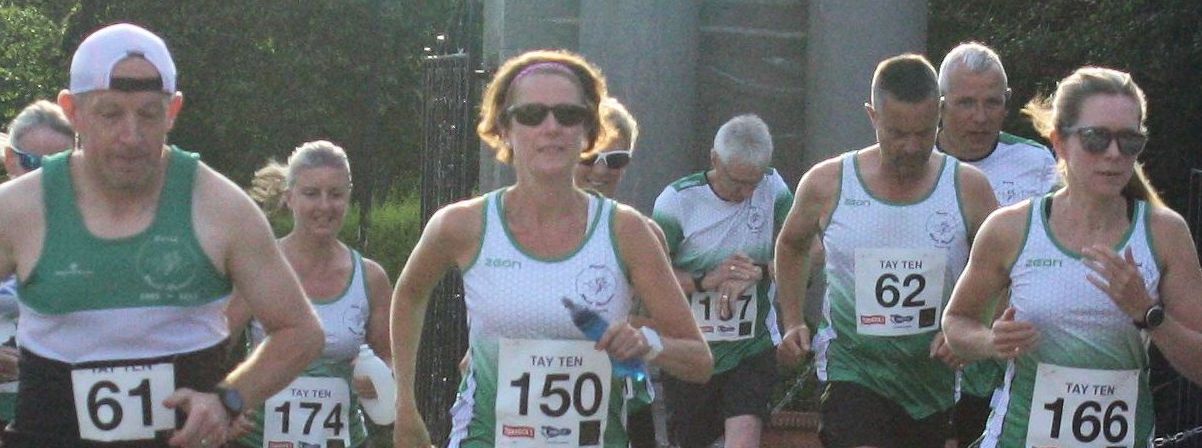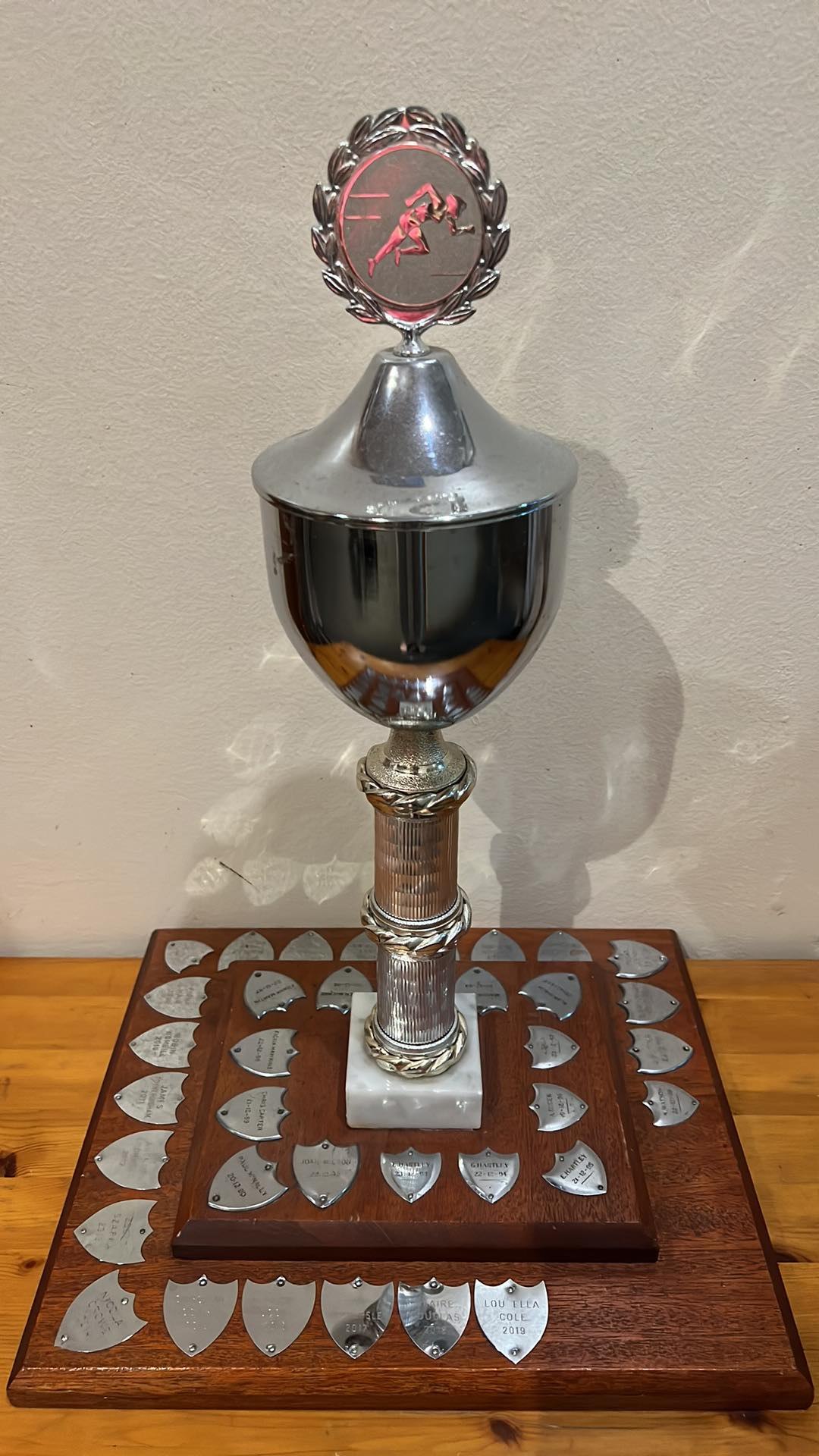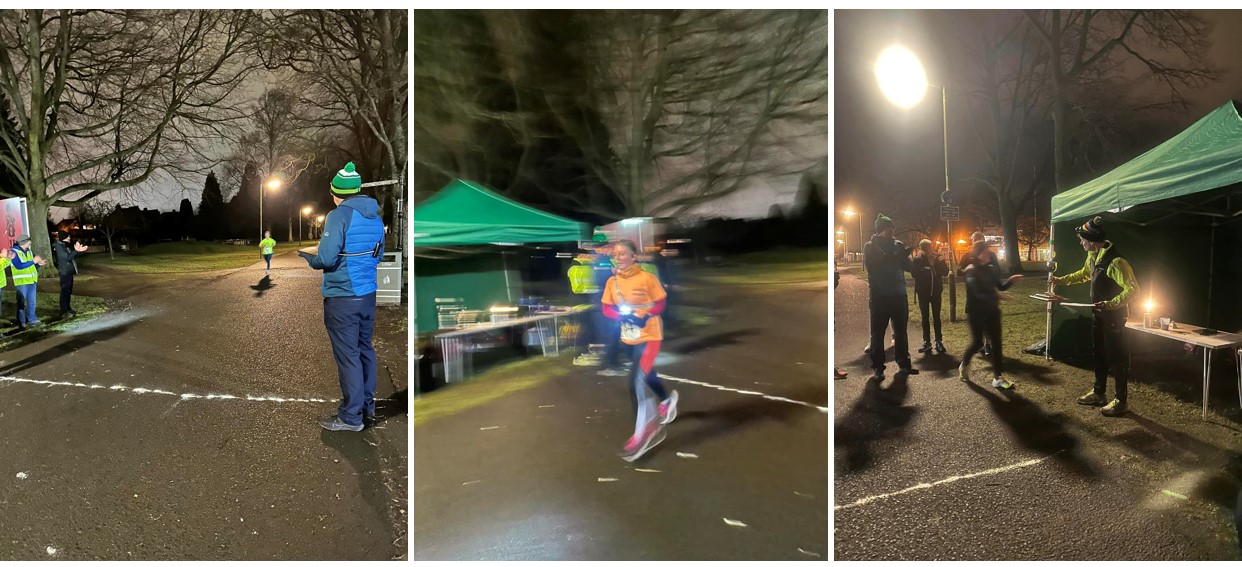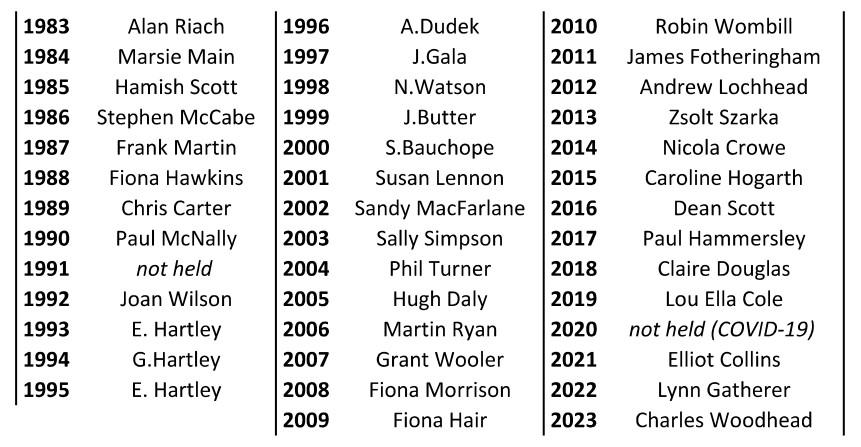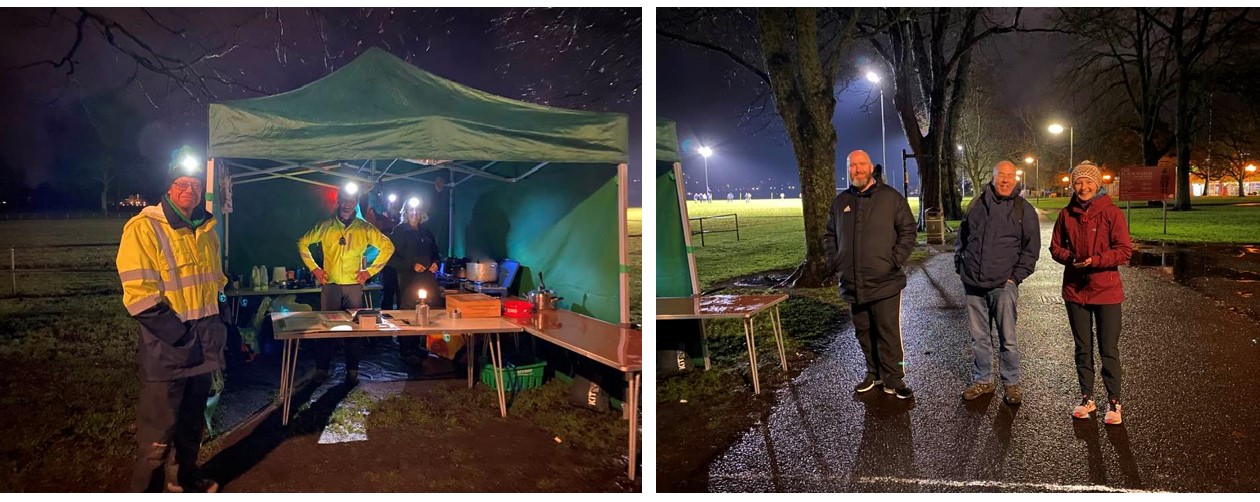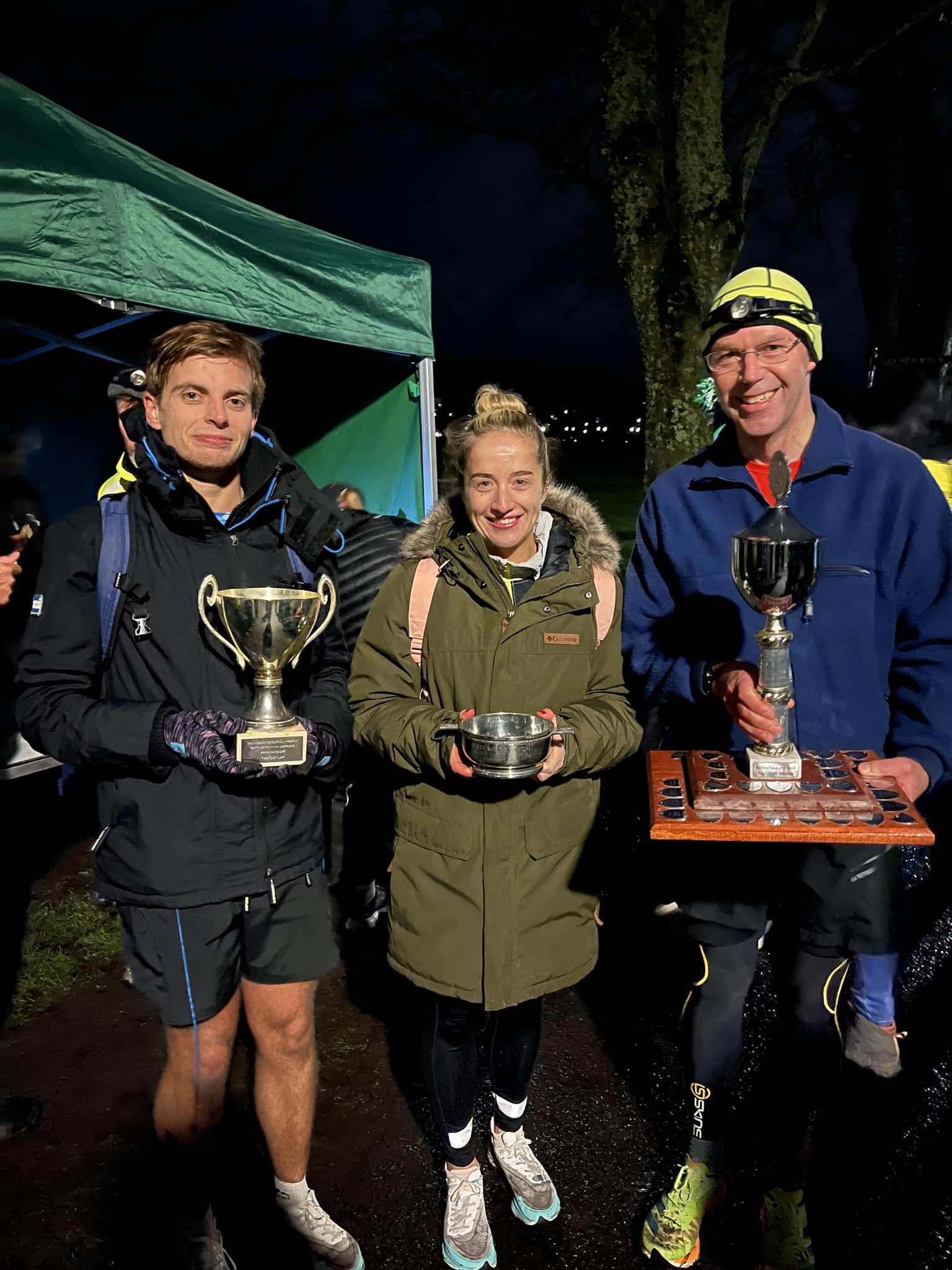The 39th running of the Yahoo was held on Tuesday 12th December 2023.
31 runners took to the dark, wet and steep roads of Perth. The results of their endeavours may be found here.
Like 007, the Yahoo will return. The difference is that we have the decency to tell you when it will (and also not pretend to kill it off with a contrived ending). See you for the 40th Yahoo on Tuesday 10th December 2024!
___
The Yahoo is weird, odd and ever-so-slightly bizarre. It is Perth Road Runners’ annual handicap race. It was first run in 1983, and its 2023 renewal was the 39th fixture. It is traditionally held in the ten days or so before Christmas, although has occasionally been delayed into the early New Year where necessary. A Christmas race it may be, but some of the most competitive performances from PRRs occur at this race in the final scrap around the North Inch for Yahoo glory.
As a handicap race, it seeks to provide an even contest for all participants, sending more leisurely/stately runners on their way before the later-starting elite athletes. The contest is held over a 9½-mile course around Perth (containing both the climb of Newhouse Road and some infamously steep slopes in Craigie; clink link for more details). The first runner over the line on the North Inch takes the leviathan trophy for which the Yahoo has become famous/notorious (potential winners are advised to bring a wheelbarrow to the event).
A key feature of the Yahoo is that it is held on an evening in December/January; that is, in the dark. This adds an extra dimension to the race. The course nowadays is marked with flour arrows to within an inch of its life (and generously marshalled). Previous course knowledge is invaluable; a recce, at the very least, is a must. It is not a night for standard club kit: runners (absolutely) must wear reflective/hi-viz/day-glo clothing (and ideally some sort of lighting). The ability to run fast when you can’t see where you’re going is particularly useful. Much of the last mile – ie the section heading upriver/North by the Tay on the North Inch – is invariably and especially dark. A full(ish) moon* helps; without one, the pre-placing of head torches under Smeaton’s Bridge is not unknown. The 2023 race falls on a new moon, so ‘extra’ darkness should be expected.
As to the history of the trophy, Club stalwart Neil Muir relates that “the trophy was donated to a group of athletes from Perth Strathtay Harriers alongside a small number of PRRs on a visit to Aschaffenburg [Perth’s twin town in Bavaria, S Germany] in the eighties. The trophy was competed for between the Aschaffenburg athletes and the Perth athletes with the German athletes visiting Perth at a later date. It was then decided that the trophy would become the trophy for the Yahoo. The Yahoo came about as the route was often used by the Harriers as a training route and decided to make it a Christmas club race and called it the Yahoo as a bit of a laugh.” The Yahoo was a Harriers race for many years (as shown here in this photo from 1996), with PRRs invited to compete, until it was effectively handed over to us to run.
A trophy is also awarded to the fastest time recorded over the course by both male and female athletes. Records of course times are not well kept; so far, I’ve struggled to find anything faster than the times posted by James Waldie and Paige Brown in the 2022 race (although the course is now marginally shorter by dint of the newly-introduced and controversial Peri-Peri Shortcut).
[* if you can see the moon, it’s because the sky is clear. If the sky is clear, it’s because there are no clouds. If there are no clouds (and in the Perth midwinter at night), it’s probably freezing. And that means the race has probably been called off as the course is too icy. The point here? Full(ish) moons at the Yahoo are rare].
Above: scenes from the Yahoo 2022
The handicap itself is always a talking point, as it shapes the final winner and finishing order every bit as much as fine runs from athletes. Until recently, participants were invited to submit estimates of the times they would achieve over the course. However, these estimates inevitably involved a major element of conservative ‘sandbagging’, giving each athlete a rather higher chance of a win. What then emerges is something of an arms race in which estimates become more and more ‘tactically wayward’. The practice of self-estimating was eliminated in the 2021 race in favour of a data-based, independent (if such a thing is possible) and mathematical stab at the handicap.
Essentially and obviously, the handicapper asks the question “how fast will this runner cover the course on the evening?” for all runners … and then staggers each of their start times, seeking to create a utopia where they all cross the finish line together. But how?
- Previous Yahoo form is the best guide.
- Races across the current season are also very useful (all the better if close to the date of the Yahoo).
- An initial step – especially where data are sparse – is to ask “how fast would this runner cover a flat parkrun today at full tilt?“.
- This time is then extrapolated up to 9.5 miles: this step also features a ‘fade factor’. Athletes known/thought/felt/believed to be better over short distances are assigned a higher fade factor; marathon runners have a lower one. [Mathematicians and number geeks may like to know that this is a power applied to the ratio of the two distances: a very low fade factor would be a power of 1.05; a high fade factor is 1.08 or even 1.09].
- There may then be a slight adjustment (+/- 1 minute max) for the hilly nature of the course; this allows for PRR having both a) runners who regard 30km + 5 Munros as a mere pre-breakfast warm-up and b) those who tremble at crossing railway bridges.
- Finally, the handicapper takes notice of the historic trend mentioned above, ie that it is very tough indeed for a faster runner to work his or her way through the entire field to win the handicap race. To this end, and also to incentivise the club’s top runners to compete, up to another 30 seconds may well be deducted from the handicap for the three or four fastest runners in the field.
- Note that the handicapper takes note of current form. It may well be that, historically, Athlete X could run much faster than they are currently displaying. Albeit with a margin of security, Athlete X is handicapped relative to their current capacity, not their historic peak.
- Newcomers with little track record (plus long-term PRRs sneakily training ‘on the quiet’) present the greatest danger to even handicapping; an additional burden to account for this uncertainty is increasingly imposed.
- For what it’s worth, this approach resulted in an average difference-from-actual-time of 1’19” across the field of competitors at the 2022 race and 2’20” in 2023.
Viewed historically, Yahoo winners (see table below) seldom emerge from the slowest end of the handicap and almost never from the fast end: winners typically tend to be saddled with a middling handicap. They are often new to the race, making it tricky for the handicappers/organisers to assess their likely performance. Once performance capability over the course is known, it is hard to escape the grip of the handicap. Consequently, only one athlete has ever won the handicap trophy twice; for that, you need to look back to E. Hartley in 1993 and 1995!
Socially, the Yahoo is on the rise. We’re seeking to create more of an after-party (such as is possible on cold, wet December evenings) at race HQ (this being the PRR gazebo/tent pitched on the edge of the North Inch at the race start). 2022 racers were offered hot chocolate, while the 2023 race added the option of steaming hot stovie(s).
Above: Race HQ at Yahoo 2023: starters/finishers, stovie chefs, North Inch marshals and general hangers-around
___
The 2023 race saw 31 runners go to post. As ever, that number fell from rather more in the last 48 hrs before the start owing to injury, illness, ‘impromptu’ Christmas parties and/or disenchantment with the allocated handicap. The race HQ team – housed within the club gazebo at the start on the North Inch – busily speculated on the likely winner and weaknesses in the handicap. As the first starter left HQ, the smart money appeared to be on Fabienne Thompson or Dean Abberley, both being viewed in rich form relative to their handicap.
Eleanor Haig set off some 40’30” ahead of Harvey Mackie, these two book-ending the handicap. The heavy rain of the day had eased, but this was no pleasant evening. A new comms channel allowed marshals out on the course to update HQ of progress and it soon appeared that our race favourites were gaining ground. But could they gain enough?
Charles Woodhead and Fabienne Thompson had set off together in the mid-pack and their mutual competition had clearly driven them on through the field (this story had been clear on the above wires). Their head torches appeared together on the finishing straight, with Charles crossing the line 22 seconds ahead*. Andy Miller took a fine (and very determined) third with Mike Souter and Dean Abberley just behind.
[* More on this story: the pair entered the last mile together, down the North Inch riverside. Fabienne – realising she was unlikely to outsprint Charles’s superior horsepower in the last hundred metres – made a number of attempts to leave the partnership, but the latter was “having none of it”. The Yahoo has seen a number of fine, noble and chivalrous acts over the years, none more so than Scott Connor’s waving through-to-win of Dean Scott in 2016. Such an act would have seen Charles wave the newly-acclaimed PRR Club Personality through to win. However, no such act occurred in 2023.]
Rhiannon Laing, who had recently emerged as ladies’ Club Champion, was clearly on the hunt for more silverware and regained the Fastest Lady quaich she won in 2021, in a fine time of 65:58, around a minute outside the unofficial course record. Meanwhile, recent men’s Champion, Elliot Collins, stormed to an an excellent 55:18 and the super-heavy – and most unattractive – Fastest Male cup.
Above: Yahoo trophy winners 2023: Elliot Collins (Fastest Male), Rhiannon Laing (Fastest Lady), Charles Woodhead (handicap trophy winner)
Full results – see link below.
A huge thank-you is due to the race HQ volunteers and marshalls (and stove providers) who made the event possible.
Resources:
2023 – Results – 31 ran
2022 – Results – 23 ran
2021 – Results – 31 ran
2020 – not held (COVID-19)
2019 – Results – 22 ran
2018 – Results – 39 ran
2017 – Results – 21 ran
2016 – Results – 38 ran
2015 – Results – 39 ran
